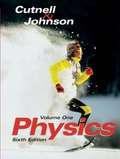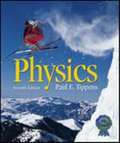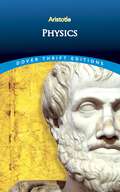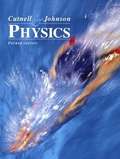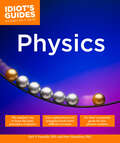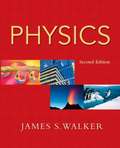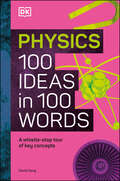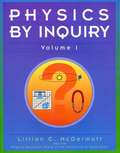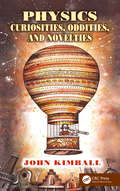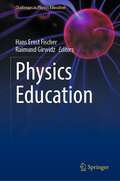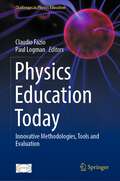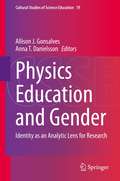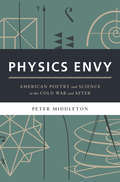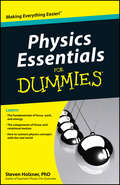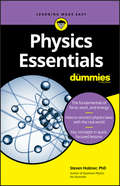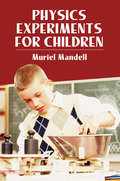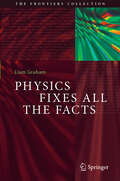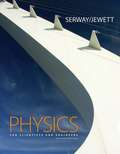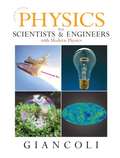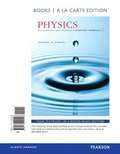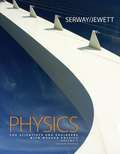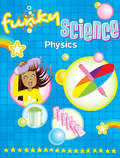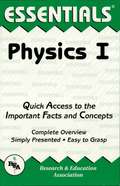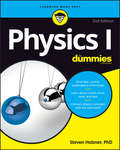- Table View
- List View
Physics (6th Edition)
by John D. Cutnell Kenneth W. JohnsonThis Sixth Edition helps readers understand the interrelationships among basic physics concepts and how they fit together to describe our physical world. Throughout the book, the authors emphasize the relevance of physics to our everyday lives. Real-world physics applications, including many biomedical applications, show how physics principles come into play over and over again in our lives. Problem Solving Insights explain each calculation in detail, guiding readers through the quantitative process Includes a CD containing physics simulations
Physics (7th Edition)
by Paul E. Tippens"Physics, Seventh Edition" is designed for the non-calculus physics course taken by students who are pursuing careers in science or engineering technology. Content is built through extensive use of examples with detailed solutions designed to develop students' problem-solving skills.
Physics (Dover Thrift Editions #Vol. 2)
by AristotleWritten in the fourth century BCE by Greek philosopher and scientist Aristotle, Physics set out to define the principles and causes of change, movement, and motion. For 2,000 years ― until discoveries by Galileo, Newton, and other scientists ― this treatise was the primary source for explanations of falling rocks, rising flames, the circulation of air, and other physical phenomena. Modern readers are required to bring a keen sense of criticism to these writings. Although Aristotle incorporated some degree of experience and observation in his thinking, the root of his reasoning lies in the philosophical approach. The brilliance of the philosopher's mind and his articulate manner of expression, together with the fact that he was among the first to undertake an intellectually rigorous investigation of nature's basic properties, contribute to the historic value of this book. It remains a foundational work of modern science and philosophy and a key to understanding the work of subsequent theorists and scholars.
Physics (Fourth Edition)
by John D. Cutnell Kenneth W. JohnsonThe book facilitates both learning and teaching processes. It aims at helping students develop conceptual understanding and use it for solving problems in areas like Thermal Physics, Magnetism, Light, Optics, Modern Physics etc.
Physics (Idiot's Guides)
by Paul V. Pancella Marc HumphreyPhysics can be a complex and intimidating subject. Idiot's Guides: Physics breaks down the complex topics of physics and makes them easy to understand. Readers will learn from numerous examples and problems that teach all of the fundamentals — Newton's Laws, thermodynamics, mass, energy and work, inertia, velocity and acceleration, and more!
Physics (Second Edition)
by James S. WalkerThis introduction to algebra-based physics covers the full spectrum of topics in Mechanics, Thermal Physics, Electromagnetism, Light and Optics, and Modern Physics.
Physics 100 Ideas in 100 Words: A Whistle-stop Tour of Science's Key Concepts
by DKGet to grips with the essential topics in physics today through 100 key ideas, each one explained clearly in 100 words.Physics: 100 Ideas in 100 Words offers the essential facts at your fingertips, satisfying your scientific curiosity and helping you to understand the biggest concepts in physics in concise, 100-word summaries. One of the first titles in a cutting-edge new series created in partnership with The Science Museum, this book introduces 100 key areas of physics such as gravity, motion, magnetism and quantum physics, and explains each topic in just 100 words. Perfect for getting your head around big ideas clearly and quickly, or refreshing your memory of the fundamentals of physics, this book covers the most up-to-date terms and theories and inspires a heightened level of understanding and enjoyment to the core areas of physics.
Physics By Inquiry: An Introduction to Physics and the Physical Sciences, Vol. 1
by Lillian C. Mcdermott Physics Education Group StaffThese volumes consist of a set of interactive based modules that offer a step-by-step introduction to physics and the physical sciences. Through an in-depth study of a few fundamental concepts, readers develop critical scientific reasoning skills. Volume 1 introduces basic physical ideas and includes topics which represent the essential background for the study of physical sciences.
Physics Curiosities, Oddities, and Novelties
by John KimballAn Enlightening Way to Navigate through Mind-Boggling Physics ConceptsPhysics Curiosities, Oddities, and Novelties highlights unusual aspects of physics and gives a new twist to some fundamental concepts. The book covers both classical and modern physics in an engaging, straightforward style.The author presents perplexing questions that often lack
Physics Education (Challenges in Physics Education)
by Raimund Girwidz Hans Ernst FischerThis book offers a comprehensive overview of the theoretical background and practice of physics teaching and learning and assists in the integration of highly interesting topics into physics lessons. Researchers in the field, including experienced educators, discuss basic theories, the methods and some contents of physics teaching and learning, highlighting new and traditional perspectives on physics instruction. A major aim is to explain how physics can be taught and learned effectively and in a manner enjoyable for both the teacher and the student. Close attention is paid to aspects such as teacher competences and requirements, lesson structure, and the use of experiments in physics lessons. The roles of mathematical and physical modeling, multiple representations, instructional explanations, and digital media in physics teaching are all examined. Quantitative and qualitative research on science education in schools is discussed, as quality assessment of physics instruction. The book is of great value to researchers involved in the teaching and learning of physics, to those training physics teachers, and to pre-service and practising physics teachers.
Physics Education Today: Innovative Methodologies, Tools and Evaluation (Challenges in Physics Education)
by Claudio Fazio Paul LogmanThis book provides an in-depth exploration of the latest developments in physics education. It presents a comprehensive look into cutting-edge research and ideas used to improve physics education around the world. Topics covered include (but are not limited to) the use of problem-based learning, the design and evaluation of teaching materials, and the use of digital technologies. This book is essential for anyone looking to stay up-to-date on the latest educational innovations and to develop an understanding of effective teaching approaches. It is aimed at researchers, teachers, students, policymakers, and educational leaders in the field of physics education.
Physics Education and Gender: Identity as an Analytic Lens for Research (Cultural Studies of Science Education #19)
by Allison J. Gonsalves Anna T. DanielssonThis Edited Volume engages with concepts of gender and identity as they are mobilized in research to understand the experiences of learners, teachers and practitioners of physics. The focus of this collection is on extending theoretical understandings of identity as a means to explore the construction of gender in physics education research. This collection expands an understanding of gendered participation in physics from a binary gender deficit model to a more complex understanding of gender as performative and intersectional with other social locations (e.g., race, class, LGBT status, ability, etc). This volume contributes to a growing scholarship using sociocultural frameworks to understand learning and participation in physics, and that seeks to challenge dominant understandings of who does physics and what counts as physics competence. Studying gender in physics education research from a perspective of identity and identity construction allows us to understand participation in physics cultures in new ways. We are able to see how identities shape and are shaped by inclusion and exclusion in physics practices, discourses that dominate physics cultures, and actions that maintain or challenge structures of dominance and subordination in physics education. The chapters offered in this book focus on understanding identity and its usefulness in various contexts with various learner or practitioner populations. This scholarship collectively presents us with a broad picture of the complexity inherent in doing physics and doing gender.
Physics Envy
by Peter MiddletonAt the close of the Second World War, modernist poets found themselves in an increasingly scientific world, where natural and social sciences claimed exclusive rights to knowledge of both matter and mind. Following the overthrow of the Newtonian worldview and the recent, shocking displays of the power of the atom, physics led the way, with other disciplines often turning to the methods and discoveries of physics for inspiration. In Physics Envy, Peter Middleton examines the influence of science, particularly physics, on American poetry since World War II. He focuses on such diverse poets as Charles Olson, Muriel Rukeyser, Amiri Baraka, and Rae Armantrout, among others, revealing how the methods and language of contemporary natural and social sciences--and even the discourse of the leading popular science magazine Scientific American--shaped their work. The relationship, at times, extended in the other direction as well: leading physicists such as Robert Oppenheimer, Werner Heisenberg, and Erwin Schrödinger were interested in whether poetry might help them explain the strangeness of the new, quantum world. Physics Envy is a history of science and poetry that shows how ultimately each serves to illuminate the other in its quest for the true nature of things.
Physics Essentials For Dummies
by Steven HolznerFor students who just need to know the vital concepts of physics, whether as a refresher, for exam prep, or as a reference, Physics Essentials For Dummies is a must-have guide. Free of ramp-up and ancillary material, Physics Essentials For Dummies contains content focused on key topics only. It provides discrete explanations of critical concepts taught in an introductory physics course, from force and motion to momentum and kinetics. This guide is also a perfect reference for parents who need to review critical physics concepts as they help high school students with homework assignments, as well as for adult learners headed back to the classroom who just need a refresher of the core concepts.The Essentials For Dummies SeriesDummies is proud to present our new series, The Essentials For Dummies. Now students who are prepping for exams, preparing to study new material, or who just need a refresher can have a concise, easy-to-understand review guide that covers an entire course by concentrating solely on the most important concepts. From algebra and chemistry to grammar and Spanish, our expert authors focus on the skills students most need to succeed in a subject.
Physics Essentials For Dummies
by Steven HolznerPhysics Essentials For Dummies (9781119590286) was previously published as Physics Essentials For Dummies (9780470618417). While this version features a new Dummies cover and design, the content is the same as the prior release and should not be considered a new or updated product. For students who just need to know the vital concepts of physics, whether as a refresher, for exam prep, or as a reference, Physics Essentials For Dummies is a must-have guide. Free of ramp-up and ancillary material, Physics Essentials For Dummies contains content focused on key topics only. It provides discrete explanations of critical concepts taught in an introductory physics course, from force and motion to momentum and kinetics. This guide is also a perfect reference for parents who need to review critical physics concepts as they help high school students with homework assignments, as well as for adult learners headed back to the classroom who just need a refresher of the core concepts. The Essentials For Dummies SeriesDummies is proud to present our new series, The Essentials For Dummies. Now students who are prepping for exams, preparing to study new material, or who just need a refresher can have a concise, easy-to-understand review guide that covers an entire course by concentrating solely on the most important concepts. From algebra and chemistry to grammar and Spanish, our expert authors focus on the skills students most need to succeed in a subject.
Physics Experiments for Children (Dover Children's Science Books)
by Muriel MandellWhat better way is there to learn than by doing? This unusual book enables children to carry out more than 103 different experiments and demonstrations, carefully planned to illustrate principles of modern science. Clear step-by-step instructions, frequent diagrams, and clear statements of conclusions all enable the young student to carry through these experiments with minimal supervision, yet full success.The science projects included demonstrate what things are made of and how substances are affected by the different forms of energy, heat, light, sound, mechanical energy, electricity, and magnetism. The experiments show how a thermometer measures temperature, how an electric bulb gives light, how shadows are formed, how a stethoscope works, how to make a periscope, how to make a rainbow, how straws work, how water changes size, and many other fascinating facts. Little is required in the way of equipment other than simple materials found at home, such as bottles, cardboard, wire, nails, cork, paper, and magnets.This volume offers upper grade school, junior high school, and high school students a very entertaining way to enrich their background in science and its applications. It is also a very valuable aid to parents, teachers, and others who wish to make clear, forceful demonstrations to children.
Physics Fixes All the Facts (The Frontiers Collection)
by Liam GrahamComplex systems seem to magically emerge from the interactions of their parts. A whirlpool emerges from water molecules. A living cell from organic molecules. You emerge from the cells of your body. Not since chaos has a concept from physics spread like wildfire to other disciplines. Emergence can be found from chemistry to economics; from psychology to ecology. At its heart is the alluring idea that there’s more to the world than physics, that there is a holistic component to nature, an edge of mystery. “Physics Fixes All the Facts” starts by taking you on a tour through a fascinating world of complexity, exploring phenomena from the inside of an atomic nucleus to bacterial behaviour to the ability of your thoughts to affect the world. These examples are used along with a thorough exploration of the philosophical literature to untangle the notoriously poorly defined concept of emergence. This reveals something surprising: the term emergence is redundant. In its weak form it is so weak that it applies to everything. In its strong form it is so restrictive that it is like the belief that there are pixies in your garden, impossible to exclude but not worth spending your time on. Emergence either applies to all systems or to none. Rather than telling us something about the nature of the world, it is an illusion, an artefact of our cognitive limitations. The past decade has seen a dozen or so monographs and collections about emergence, almost all resolutely supportive of the concept. This book aims to redress the balance. But it is more than just a campaign against the idea of emergence. Graham presents a framework called Austere Physicalism and argues that it is the only coherent way to view the world. He uses this framework to reinterpret so-called emergent phenomena and investigates its wider implications for science. In this radically materialist view, we are nothing but physical systems among others. “Physics Fixes All the Facts” ends by exploring what this means for our sense of free will and consciousness. The book will appeal to academics in fields which use the concepts of complexity or emergence. Scientists and philosophers alike will find unexpected and exciting ideas in these pages. But the target audience is much broader including students who want to add context to their studies and the intellectually curious with some scientific background.
Physics For Scientists And Engineers (Seventh Edition)
by Raymond A. Serway John W. JewettSerway (professor emeritus, James Madison University) and Jewett (physics, California State Polytechnic University) integrate Web-based media resources in this seventh edition of an introductory physics text for students majoring in science or engineering.
Physics For Scientists And Engineers With Modern Physics
by Douglas C. GiancoliPhysics for Scientists and Engineers combines outstanding pedagogy with a clear and direct narrative and applications that draw the student into the physics. The new edition also features an unrivaled suite of media and on-line resources that enhance the understanding of physics. This book is written for students. It aims to explain physics in a readable and interesting manner that is accessible and clear, and to teach students by anticipating their needs and difficulties without oversimplifying. Physics is a description of reality, and thus each topic begins with concrete observations and experiences that students can directly relate to. We then move on to the generalizations and more formal treatment of the topic. Not only does this make the material more interesting and easier to understand, but it is closer to the way physics is actually practiced.
Physics For Scientists And Engineers: A Strategic Approach
by Randall KnightFor courses in introductory calculus-based physics. A research-driven approach, fine-tuned for even greater ease-of-use and student success For the Fourth Edition of Physics for Scientists and Engineers, Knight continues to build on strong research-based foundations with fine-tuned and streamlined content, hallmark features, and an even more robust MasteringPhysics program, taking student learning to a new level. By extending problem-solving guidance to include a greater emphasis on modeling and significantly revised and more challenging problem sets, students gain confidence and skills in problem solving. A modified Table of Contents and the addition of advanced topics now accommodate different teaching preferences and course structures.
Physics For Scientists And Engineers: Volume 2, Chapters 23-46
by Raymond A. Serway John W. JewettAchieve success in your physics course by making the most of what PHYSICS FOR SCIENTISTS AND ENGINEERS has to offer you. From a host of in-text features to a range of outstanding technology resources, you'll have everything you need to understand the natural forces and principles of physics. Throughout every chapter, the authors have built in a wide range of examples, exercises, and illustrations that will help you understand the laws of physics AND succeed in your course! Available with most new copies of the text is CengageNOW for Physics. Save time, learn more, and succeed in the course with this online suite of resources that give you the choices and tools you need to study smarter and get the grade. Receive a personalized study plan based on chapter-specific diagnostic testing to help you pinpoint what you need to know NOW, and interact with a live physics tutor through the exclusive Personal Tutor with SMARTHINKING program to help you master the concepts.
Physics Funky Science (Funky Science)
by Kirsten HallSmart and savvy girls will love discovering the secrets of science! Funky Science: Physics has loads of cool, creative experiments presented in a fun and accessible way, relating to topics that girls love. Grab some friends to make some noise, create a rainbow, uncover the secrets of light, discover the mysteries of energy, and put the fun in Funky Physics! All experiments are developed with science teachers and provide the science behind the activity along with parental guidance symbols and glossaries of Wonder Words.
Physics I Essentials (Essentials Study Guides #1)
by The Editors of REAREA's Essentials provide quick and easy access to critical information in a variety of different fields, ranging from the most basic to the most advanced. As its name implies, these concise, comprehensive study guides summarize the essentials of the field covered. Essentials are helpful when preparing for exams, doing homework and will remain a lasting reference source for students, teachers, and professionals. Physics I includes vectors and scalars, one-dimensional motion, plane motion, dynamics of a particle, work and energy, conservation of energy, dynamics of systems of particles, rotational kinematics and dynamics, harmonic motion, sound waves, gravitation, equilibrium of rigid bodies, fluid statics and dynamics, temperature, heat and the first law of thermodynamics, kinetic theory of gases, and entropy and the second law of thermodynamics.
Physics I For Dummies
by Steven HolznerThe fun and easy way to get up to speed on the basic concepts of physicsFor high school and undergraduate students alike, physics classes are recommended or required courses for a wide variety of majors, and continue to be a challenging and often confusing course.Physics I For Dummies tracks specifically to an introductory course and, keeping with the traditionally easy-to-follow Dummies style, teaches you the basic principles and formulas in a clear and concise manner, proving that you don't have to be Einstein to understand physics!Explains the basic principles in a simple, clear, and entertaining fashionNew edition includes updated examples and explanations, as well as the newest discoveries in the fieldContains the newest teaching techniquesIf just thinking about the laws of physics makes your head spin, this hands-on, friendly guide gets you out of the black hole and sheds light on this often-intimidating subject.
